Collaboration Journal
Special Feature
The Role of the Avatar
MARTHA ORTON
THE COLLABORATION JOURNAL SPECIAL FEATURES series highlights notable articles from Collaboration journal and makes them available to readers without a subscription. A discussion of this article with Martha Orton, Jonathan Kay, and Marco Masi is available on the Sri Aurobindo Association YouTube channel, Collaboration Podcast, Episode 4.
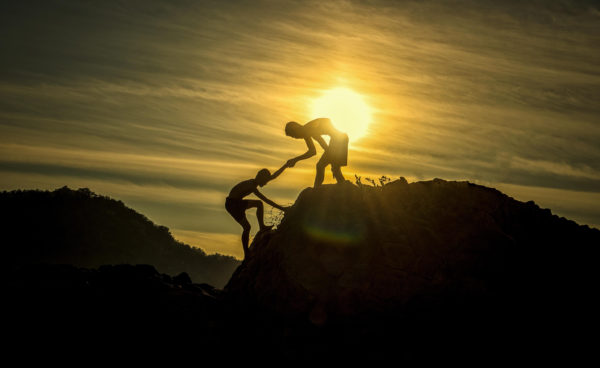
What Sri Aurobindo represents in the world’s history is not a teaching, not even a revelation; it is a decisive action direct from the Supreme.—The Mother1
Since the beginning of the earth, wherever and whenever there was the possibility of manifesting a ray of the Consciousness, I was there.—The Mother2
HUMANITY INHERENTLY HAS a sense of a higher and better life beyond our usual earthly existence. Those who believe in a higher power often seek solace in such an idea and also hope, or even expect, that a divine presence has lived among us in the past and may do so again. They also may believe that the Divine is involved in life and cares about humanity to the extent that a personal relationship with the Divine can be a component of daily life. Such a view is consistent with the beliefs in the Integral Yoga of Sri Aurobindo and the Mother, especially for those who accept them as the divine presence that engages with them in their spiritual seeking and also offers the potential to transform their human nature to a higher expression of itself.
In his description of the evolution of consciousness, Sri Aurobindo explains that the purpose of human life is to evolve in consciousness and to engage in a transformative process which brings all of humanity, in fact all of creation, closer to the Divine and, ultimately, to union with the Divine in a wonderful Oneness. We cannot imagine this process being at all possible without help from a higher power. While the Divine is always involved in life on earth and involved with humanity, at times the Divine has made the sacrifice of taking on human form and living among us, doing so from its great love and compassion. These beings who have made this sacrifice, divine beings in human form, are spoken of as avatars. For many in the Integral Yoga, Sri Aurobindo and the Mother are seen as the most recent avatars to live among us on earth. As Sri Aurobindo has described, human nature benefits from the presence of the avatar as an intermediary, a being close to our humanity and whose example we can use as a model.
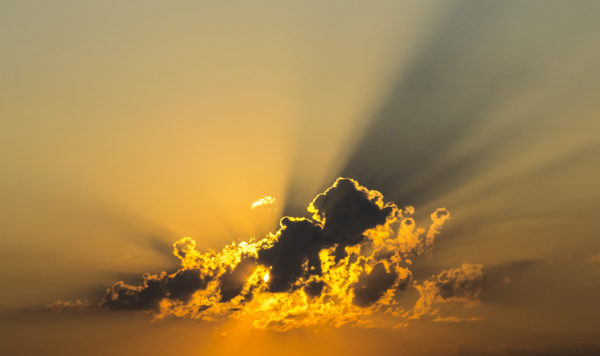
Sri Aurobindo has written about the role of the avatar in multiple texts, including in Essays on the Gita, where he gives specific focus to the avatar in the form of Lord Krishna, the aspect and form of the Divine central to the Gita. Also, writing on the theme of offering and sacrifice in The Synthesis of Yoga, he addresses the nature of the sacrifice which the Divine makes when it comes to earth in human form. We also discover much about the role the avatar plays in human spirituality in Sri Aurobindo’s profound small volume, The Mother. The present essay proposes to highlight some of the aspects of this topic which Sri Aurobindo has shared with us with greater eloquence and fullness in his writings.
The primary and central role played by the avatar is to establish a physical, concrete link between heaven and earth, the Divine and its creation. Sri Aurobindo explains in his conceptualization of the evolution of consciousness that not only did the Divine create the universe and all in it out of itself, but the Divine is naturally integrally within it (i.e., involved in it in the most literal sense). Furthermore the concept of Brahman necessarily includes the inherent connection between the Divine and the manifestation, for as Sri Aurobindo quotes from the Bhagavad Gita, “All is the Divine Being.”3 Sri Aurobindo gives us the most complete and comprehensive interpretation of Brahman in asserting that this applies to all of the material universe down to the atomic level. He writes: “For all here is God, is the Spirit or Self-existence, is Brahman, ekamevādvitīyam,—there is nothing else, nothing other and different from it and there can be nothing else, can be nothing other and different from it …”4 Accepting this as truth, we might ask why such a physical link as the presence of the avatar is necessary.
The answer to this salient question also lies within Sri Aurobindo’s conceptualization of the evolution of consciousness; for he explains that what is involved must evolve—that is, the Divine presence in the creation both enables the evolution of its consciousness and makes this evolution inevitable. The avatar comes to earth to help advance this process—to enable humanity and all the material world to evolve and manifest their inherent divine nature more fully than they might otherwise be able to do. One of the most powerful and compelling passages in the Gita is Krishna’s declaration to Arjuna, the warrior who faces the challenge of battling his kin, of his presence and purpose, which Sri Aurobindo translates as follows:
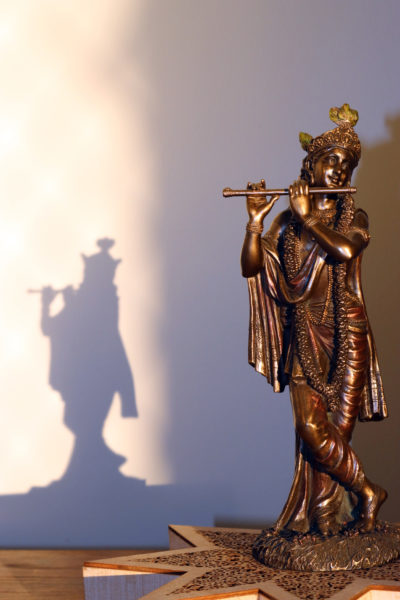
Many are my lives that are past, and thine also, O Arjuna; all of them I know, but thou knowest not, O scourge of the foe. Though I am the unborn, though I am imperishable in my self-existence, though I am the Lord of all existences, yet I stand upon my own Nature and I come into birth by my self-Maya. For whensoever there is the fading of the Dharma and the uprising of unrighteousness, then I loose myself forth into birth. For the deliverance of the good, for the destruction of the evil-doers, for the enthroning of the Right I am born from age to age. He who knoweth thus in its right principles my divine birth and my divine work, when he abandons his body, comes not to rebirth, he comes to Me, O Arjuna. Delivered from liking and fear and wrath, full of me, taking refuge in me, many purified by austerity of knowledge have arrived at my nature of being (madbhāvam), the divine nature of the Purushottama [the Supreme Divine]. As men approach me, so I accept them to my love (bhajāmi); men follow in every way my path, O son of Pritha.5
While recognizing the role of the avatar as bringing humanity closer to the Divine, Sri Aurobindo additionally asserts that the avatar’s purpose extends even farther to enabling and assisting in the transformation of human nature into its divine counterpart. He writes specifically to this point in Essays on the Gita when he explains that it is not only for upholding the Dharma that Lord Krishna has come to earth to assist Arjuna:
But we have to remark carefully that the upholding of Dharma in the world is not the only object of the descent of the Avatar, that great mystery of the Divine manifest in humanity; for the upholding of the Dharma is not an all-sufficient object in itself, not the supreme possible aim for the manifestation of a Christ, a Krishna, a Buddha, but is only the general condition of a higher aim and a more supreme and divine utility. For there are two aspects of the divine birth; one is a descent, the birth of God in humanity, the Godhead manifesting itself in the human form and nature, the eternal Avatar; the other is an ascent, the birth of man into the Godhead, man rising into the divine nature and consciousness, madbhāvam āgataḥ; it is the being born anew in a second birth of the soul. It is that new birth which Avatarhood and the upholding of the Dharma are intended to serve.6
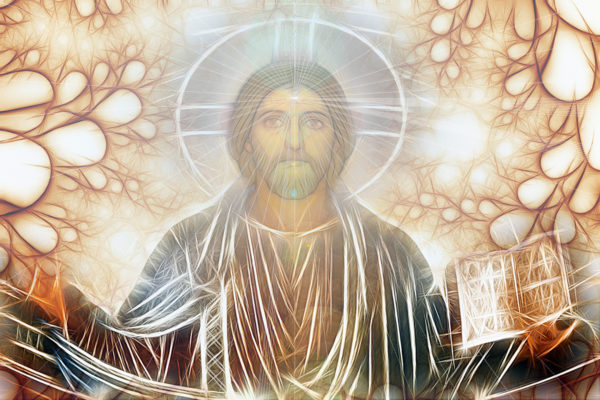
Sri Aurobindo further emphasizes the significance he gives to the role of the avatar in transforming humanity:
This double aspect in the Gita’s doctrine of Avatarhood is apt to be missed by the cursory reader satisfied, as most are, with catching a superficial view of its profound teachings, and it is missed too by the formal commentator petrified in the rigidity of the schools. Yet it is necessary, surely, to the whole meaning of the doctrine. Otherwise the Avatar idea would be only a dogma, a popular superstition, or an imaginative or mystic deification of historical or legendary supermen, not what the Gita makes all its teaching, a deep philosophical and religious truth and an essential part of or step to the supreme mystery of all, rahasyam uttamam.
If there were not this rising of man into the Godhead to be helped by the descent of God into humanity, Avatarhood for the sake of the Dharma would be an otiose phenomenon, since mere Right, mere justice or standards of virtue can always be upheld by the divine omnipotence through its ordinary means, by great men or great movements, by the life and work of sages and kings and religious teachers, without any actual incarnation.7
Reflecting on the role of the avatar, we cannot but recognize the vast extent of divine compassion in engaging so directly with humanity at its own level of being. Without this direct example to lead us forward, we would be much more likely to stay mired in the smallness of our surface being and nature. Sri Aurobindo describes the great mission and purpose of the avatar:
The Avatar comes as the manifestation of the divine nature in the human nature, the apocalypse of its Christhood, Krishnahood, Buddhahood, in order that the human nature may by moulding its principle, thought, feeling, action, being on the lines of that Christhood, Krishnahood, Buddhahood transfigure itself into the divine. The law, the Dharma which the Avatar establishes is given for that purpose chiefly; the Christ, Krishna, Buddha stands in its centre as the gate, he makes through himself the way men shall follow. That is why each Incarnation holds before men his own example and declares of himself that he is the way and the gate; he declares too the oneness of his humanity with the divine being, declares that the Son of Man and the Father above from whom he has descended are one, that Krishna in the human body, mānuṣīṁ tanum āśritam, and the supreme Lord and Friend of all creatures are but two revelations of the same divine Purushottama, revealed there in his own being, revealed here in the type of humanity.8
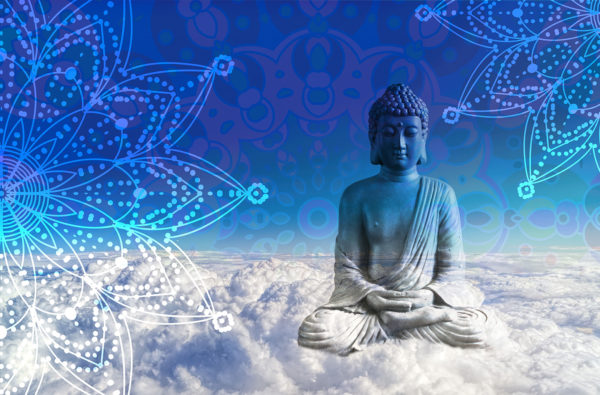
Further reflecting on the role of the avatar, we can feel deeply humbled and grateful for the concrete physical presence of the Divine on earth and consider the enormity of the sacrifice which this represents. Sri Aurobindo has written of the nature of this sacrifice in The Synthesis of Yoga, describing the concept of sacrifice as a dynamic process central to the Integral Yoga. He has written extensively on this concept and given it particular emphasis in three chapters of Book I of The Synthesis of Yoga. In Chapter IV, titled “The Sacrifice, the Triune Path and the Lord of the Sacrifice,” Sri Aurobindo describes two major forms of sacrifice that occur in the universe.
The first of these is the sacrifice made by the Divine through the descent of the purusha from the vast transcendent oneness into the world and matter. This sacrifice, the highest and greatest, precedes the second, the sacrifice made by the manifest universe to the Divine. The sacrifice made by the Divine in coming into matter initiates and enables the sacrifice which the manifestation can make through its self-offering to the Divine. Sri Aurobindo states: “This descent, the sacrifice of the Purusha, the Divine Soul submitting itself to Force and Matter so that it may inform and illuminate them, is the seed of redemption of this world of lnconscience and Ignorance.”9
The second form of sacrifice is that made by the manifest existence in its unconscious or conscious growth towards the Divine. This sacrifice ultimately leads human beings onto the triune path of yoga, in which the paths of works, knowledge, and devotion merge, and to union with the Divine. The arduous and immeasurably lengthy sacrificial process of humanity’s evolution is indeed great. Yet we can barely imagine the magnitude of the sacrifice made by the Divine in taking on human form and living among us in that guise. The avatar takes on the human body, with all the difficulties and forms of suffering implied in this manifestation. Although the avatar has the capability of performing miracles and avoiding any form of personal suffering, he or she takes on the sufferings associated with life in a human body for our sake, showing how they can be endured as a form of redemption or overcome even within our nature. Sri Aurobindo conveys a sense of this reality in Savitri, as we can see in the following lines:
Thou hast come down into a struggling world.
To aid a blind and suffering mortal race,
To open to Light the eyes that could not see,
To bring down bliss into the heart of grief,
To make thy life a bridge twixt earth and heaven;
If thou wouldst save the toiling universe,
The vast universal suffering feel as thine:
Thou must bear the sorrow that thou claimst to heal;
The day-bringer must walk in darkest night.
He who would save the world must share its pain.
If he knows not grief, how shall he find grief’s cure?
If far he walks above mortality’s head,
How shall the mortal reach that too high path?
If one of theirs they see scale heaven’s peaks,
Men then can hope to learn that titan climb.
God must be born on earth and be as man.
That man being human may grow even as God.
He who would save the world must be one with the world,
All suffering things contain in his heart’s space
And bear the grief and joy of all that lives.10
For humanity, immense gratitude needs to be our response, along with receptivity to change and transformation. We can ask ourselves the question: “Where would we be without some recognition in our awareness of the Divine?” The answer for most of us would be simply that we would feel lost. The very presence of the avatar assists humanity in its recognition of the reality of the Divine. Moreover, the actual physical presence of the Divine in human form also greatly assists in developing a personal relationship with the Divine, because the avatar is much more approachable than the vaster forms and aspects of the Divine. In essence, the greater divine reality is far too vast for the human mind to conceive of and, in its vastness, too impersonal for it to approach. Even if we could conceive of it, the Divine in its transcendent aspect would be overwhelming to us. Since the divine reality exists at levels beyond our grasp, as the transcendent and the universal, humanity is blessed with the Divine in the personal, individual form of the avatar. Humanity greatly needs the avatar in order to develop personal connection with the Divine. Without developing a personal relationship with the Divine, we can have little sense of guidance, and certainly little experience of emotional connection and devotion. The interplay and exchange of both of these is essential to our growth and transformation.
Sri Aurobindo explains that the presence of the avatar among humanity on earth offers a concrete example of how we can progress in our personal and individual development. He writes: “It is, we might say, to exemplify the possibility of the Divine manifest in the human being, so that man may see what that is and take courage and grow into it.”11 This presents itself as a dual action beginning with the birth of the Divine into human form, and subsequently followed by the ascent of humanity into its higher, divine nature. Moreover, the avatar offers a teaching which usually has become a sacred text for his or her followers to enrich their understanding and practice of the path which the avatar presents as a possibility for their future.
Sri Aurobindo also explains that the influence of the Divine on earth manifested in the form of the avatar leaves a lingering vibration and presence that continues to have profound and wide-reaching effect on human life and the evolutionary advance. Pertinent to this inspiring understanding, Sri Aurobindo writes: “The divine manifestation of a Christ, Krishna, Buddha in external humanity has for its inner truth the same manifestation of the eternal Avatar within in our own inner humanity. That which has been done in the outer human life of earth, may be repeated in the inner life of all human beings.”12
Writing in The Mother, Sri Aurobindo describes wonderfully all the ways in which the Divine interacts with humanity in its sacrifice of engagement with us and he also describes the necessity of our full receptivity and surrender to the Divine in order to receive the blessings offered to us. The following passages reflect some of the beauty of this text and speak powerfully to necessity of the role of the avatar:
The One whom we adore as the Mother is the divine Conscious Force that dominates all existence, one and yet so many-sided that to follow her movement is impossible even for the quickest mind and for the freest and most vast intelligence. The Mother is the consciousness and force of the Supreme and far above all she creates. But something of her ways can be seen and felt through her embodiments and the more seizable because more defined and limited temperament and action of the goddess forms in whom she consents to be manifest to her creatures.
There are three ways of being of the Mother of which you can become aware when you enter into touch of oneness with the Conscious Force that upholds us and the universe. Transcendent, the original supreme Shakti, she stands above the worlds and links the creation to the ever unmanifest mystery of the Supreme. Universal, the cosmic Mahashakti, she creates all these beings and contains and enters, supports and conducts all these million processes and forces. Individual, she embodies the power of these two vaster ways of her existence, makes them living and near to us and mediates between the human personality and the divine Nature.13
Notes
1 The Mother, Words of the Mother—I, Collected Works of the Mother, vol. 13, p. 4
2 Ibid., p. 37
3 Sri Aurobindo, The Life Divine, Collected Works of Sri Aurobindo (CWSA), vols. 21–22, p. 309
4 Sri Aurobindo, Essays on the Gita, CWSA, vol. 19, p. 151
5 Ibid., pp. 146–147
6 Ibid., pp. 147–148
7 Ibid., p. 149
8 Ibid., pp. 148–149
9 Sri Aurobindo, The Synthesis of Yoga, CWSA, vols. 23–24, p. 106
10 Sri Aurobindo, Savitri, CWSA, vols. 33–34, 536–537
11 Sri Aurobindo, Essays on the Gita, CWSA, vol. 19, p. 159
12 Ibid., p. 160

Martha Orton is a writer and scholar with a PhD in Sri Aurobindo Studies and a member of the Sri Aurobindo Association’s Editorial Advisory Board. She has been a devotee of Sri Aurobindo and the Mother for many years, having lived in both the Sri Aurobindo Ashram and Auroville, and is the author of several books and numerous journal articles on Integral Yoga. Her books include The Quest for Knowledge and Mastery: A Comparative Study of Motivation in the Light of Sri Aurobindo; Oneness; Sri Aurobindo’s Perspective on Reality & Other Essays; and Calling into the Dark (poetry).

